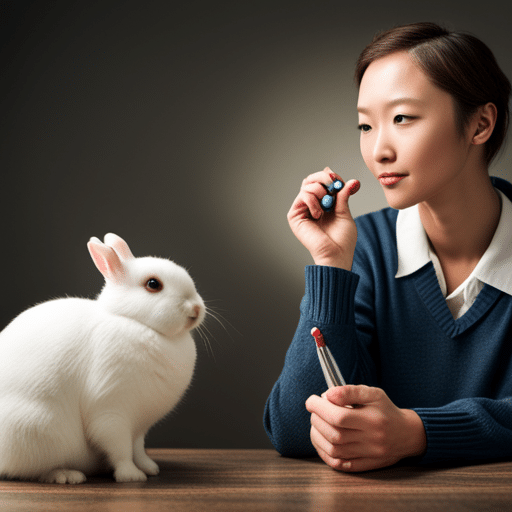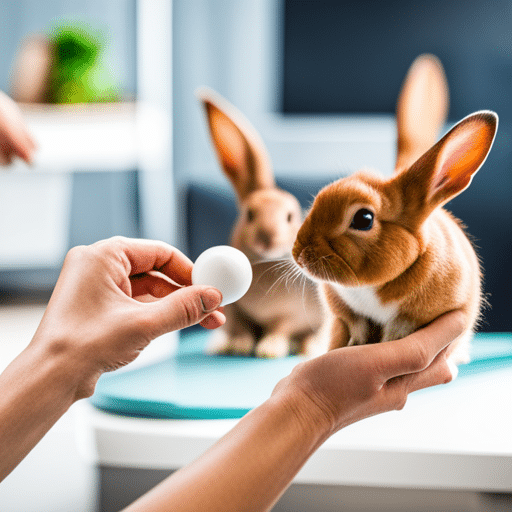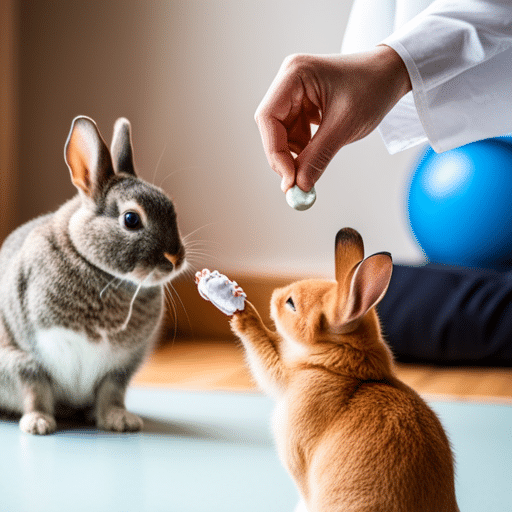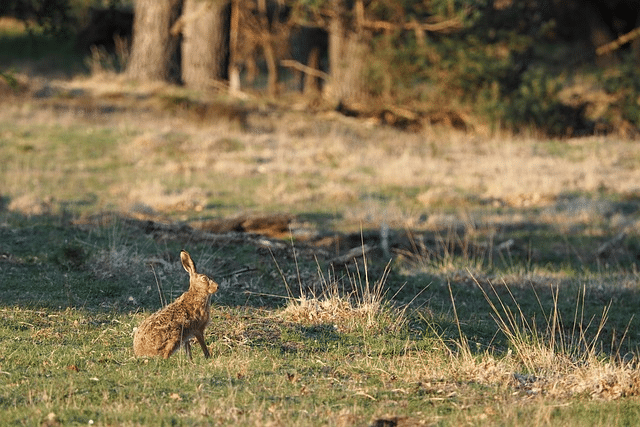Did you know that clicker training isn’t just for dogs? Rabbits can also benefit from this engaging and rewarding training method! Imagine your bunny giving you high-fives, spinning in circles, or even playing fetch. Clicker training for rabbits offers endless possibilities for both you and your furry friend while strengthening the bond between you. In this blog post, we’ll guide you through the essentials of rabbit clicker training, its fundamentals, and how to apply it in various practical situations. Get ready to embark on an exciting journey with your rabbit!
Short Summary
Strengthen your bond with your rabbit through clicker training using positive reinforcement, timing & consistency.
Use high-value treats to motivate and reward desired behaviors while introducing the clicker.
Troubleshoot common challenges for successful results & build trust between you and your pet!
Essentials for Rabbit Clicker Training

To begin your rabbit clicker training journey, you’ll need to gather a few essentials: a clicker, some high-value treats, and a suitable training environment. With the right tools and environment, you’ll be ready to teach your rabbit some amazing tricks and behaviors.
Let’s explore each essential component in more detail.
Choosing a Clicker
A clicker is a small device that emits a distinct sound when pressed, making it perfect for marking the exact moment a desired behavior is performed. There are various types of clickers available, such as plastic, metal, and even electronic versions. But don’t worry if you don’t have a clicker; you can also use a ballpoint pen, a target stick, or a verbal cue like “Yes!” as effective alternatives.
When selecting a clicker for your rabbit, consider the size and sound of the device. It should be small enough to fit snugly in your hand, and the sound should be loud enough for your rabbit to hear and recognize. The PetSafe Clik-R Trainer is an excellent choice for rabbit clicker training, as it allows you to easily incorporate hand cues.
Selecting High-Value Treats

High-value treats are the foods your rabbit loves the most and will get them excited for training. These treats can include dried fruit, rabbit pellets, vegetables, almonds, walnuts, sunflower or pumpkin seeds, cereals like rolled oats or barley, and legumes like peas or broad beans.
However, it’s essential to choose healthy treats as a food reward to ensure your bunny gets the nutrition they need without too much sugar or fat. This also helps your rabbit respond better to the cue word during clicker training.
The ideal size for training treats is tiny, perfect for rewarding your rabbit’s progress without overfeeding them. The House Rabbit Society recommends preparing about 15 tiny, scrumptious, high-value treats for a training session.
Setting Up a Training Environment
The ideal conditions for clicker training rabbits are quiet and secure, providing a sense of safety for your rabbit. You can start by keeping the sound of your clicker muffled in a pocket, under a shirt, or behind your back to prevent startling your rabbit. Positive reinforcement, like treats, is a great way to motivate your rabbit and encourage learning.
Start with basic commands like “sit”, “stay” and “come” to help your rabbit become familiar with the training process. As you progress, you can introduce more advanced techniques such as shaping behaviors, adding verbal cues and hand signals, and troubleshooting common challenges.
Fundamentals of Clicker Training
Now that you have the essentials in place, it’s time to dive into the fundamentals of clicker training. These fundamentals include the importance of timing, positive reinforcement, consistency, and patience in your training sessions.
Mastering these basics will set the foundation for a successful and enjoyable clicker training experience for both you and your rabbit.
The Importance of Timing
Timing is crucial in clicker training, as it allows you to precisely “mark” the desired behavior at the exact moment it occurs. This helps your rabbit quickly understand that the correct behavior is what earns them a reward. For example, if you reward a rabbit for coming to the door of its cage without using a clicker, they may mistakenly associate the reward with chewing on the door instead.
By using a clicker to train your rabbit to come to the door, they will quickly understand that the reward is associated with the correct behavior of coming to the door. Remember, the clicker is not a remote control for your rabbit, but rather a communication tool that helps them learn the connection between their actions and the rewards they receive.
With practice and proper timing, your rabbit will quickly learn the meaning behind the click and eagerly anticipate their treats.
Positive Reinforcement
Positive reinforcement is a powerful tool for clicker training rabbits, as it rewards desired behaviors and helps to build a strong relationship between the rabbit and the trainer. When you reward your rabbit with treats or petting for exhibiting good behavior, they are more likely to repeat that behavior in the future.
For example, if your rabbit gently touches your hand with their paw and you reward them with a click and a treat, they’ll quickly learn that this action earns them a reward. This positive association motivates your rabbit to continue learning and helps them enjoy the training process.
Consistency and Patience
Consistency and patience are essential for successful clicker training for rabbits. By providing consistent cues and rewards, you create an understanding between you and your rabbit that allows them to work at their own pace. It’s important not to rush the training process or expect too much too soon. Rabbits, like any other animal, need time to learn new behaviors and understand what is expected of them.
When clicker training, make sure to reward your rabbit every time they perform the desired behavior. This consistency helps them understand the connection between their actions and the rewards they receive.
Remember, patience is key – allow your rabbit the time they need to learn and grow in confidence, and you’ll enjoy a rewarding and fulfilling clicker training experience together.
Starting Your First Training Session

With the essentials and fundamentals covered, you’re ready to start your first clicker training session with your rabbit! In this section, we’ll guide you through introducing the clicker, teaching basic commands, and troubleshooting common challenges that may arise during training.
Let’s get started on this exciting journey with your furry friend from the animal shelter, as they learn to adapt to their new environment and overcome their instincts as prey animals!
Introducing the Clicker
When introducing the clicker to your rabbit, begin by clicking and rewarding while your rabbit is near you and not moving away. This helps them become comfortable with taking rewards from your hand and hearing the clicker sound. You can also opt for a softer clicker to make your rabbit feel more at ease.
Take a few moments to evaluate the environment, noise level, and your rabbit’s overall condition before starting a training session. If you remain calm and patient, your rabbit will likely follow suit and be more receptive to the training process.
Basic Commands
Once your rabbit is comfortable with the clicker sound and taking treats from your hand, you can start teaching basic commands like “sit,” “stay,” and “come.” Begin by placing a treat on the floor near you, and click immediately when your rabbit picks up the treat to eat, reinforcing the connection between the clicker sound and the reward.
As your rabbit becomes more familiar with the clicker and basic commands, you can gradually introduce more advanced techniques and behaviors. With patience, consistency, and positive reinforcement, your rabbit will quickly learn new tricks and enjoy a fulfilling clicker training experience.
Advanced Clicker Training Techniques

As you and your rabbit become more comfortable with clicker training, you can start exploring advanced techniques to further enhance your training sessions. In this section, we’ll discuss shaping behaviors, adding verbal cues and hand signals, and troubleshooting common challenges that may arise in advanced clicker training.
Shaping Behaviors
Shaping behaviors is a crucial part of clicker training for rabbits, as it enables you to divide complex behaviors into smaller, more achievable steps. By rewarding each step of new behavior, you can gradually progress to more complex behaviors and help your rabbit learn at their own pace.
Breaking a complex behavior into individual components and rewarding each component as it is completed helps your rabbit learn the behavior in smaller, more manageable steps. This allows them to learn more quickly and confidently, fostering trust and self-assurance in the training process.
Adding Verbal Cues and Hand Signals
Incorporating verbal cues and hand signals into your clicker training sessions can further improve communication with your rabbit and create a positive association between the desired behavior and the specific cue. When your rabbit performs a desired behavior, be sure to click the clicker and give them a treat immediately. This helps your rabbit understand that the clicker sound means a reward is coming and reinforces the connection between the cue and the behavior.
To teach your rabbit to respond to verbal cues and hand signals, try adding a hand cue at the same time the behavior is happening. For example, say “sit” as your rabbit sits, and then click and treat to reinforce the behavior. With practice, your rabbit will associate the verbal cue with the desired behavior and respond accordingly.
Troubleshooting Common Challenges
During your clicker training journey, you may face common challenges such as fear, aggression, or lack of motivation. It’s important to remain patient and find solutions to overcome these obstacles for a successful training experience.
One way to address common challenges is to adjust the volume and pitch of your clicker to suit your rabbit’s comfort level. By starting with a softer clicker and gradually increasing the volume as your rabbit grows more confident with the sound, you can help them feel more comfortable during training sessions.
Additionally, ensuring the consistency of cues and rewards can help your rabbit understand the connection between their actions and the treats they receive.
Practical Applications of Clicker Training

Clicker training, also known as clicker train, offers practical benefits for both you and your rabbit, such as becoming clicker trained for litter box training, grooming and handling, and building trust and bonding. This is why clicker training works so effectively.
In this section, we’ll explore how clicker training can be applied to everyday situations, enhancing your rabbit’s quality of life and strengthening your bond with them.
Litter Box Training
Litter box training is an essential aspect of rabbit clicker training, as it encourages cleanliness and hygiene while allowing your rabbit to roam more freely in your home. To train your rabbit to use a litter box, start by placing the box in an easily accessible spot and adding a few pieces of hay or treats to entice your rabbit to explore it. As your rabbit becomes more comfortable with the box, begin to add a small amount of litter and gradually increase the amount until they are confident using it.
Reward your rabbit with a click and a treat when they use the litter box, reinforcing the connection between the desired behavior and the reward. With patience and consistency, your rabbit will soon be litter box trained, making it easier to maintain a clean and hygienic environment for your furry friend.
Grooming and Handling
Grooming and handling are crucial for your rabbit’s well-being and trust in you as their owner. Regular grooming helps maintain your rabbit’s coat in optimal condition and can prevent potential injuries, while proper handling allows your rabbit to become accustomed to being touched and held, making vet exams and nail trims less stressful.
Clicker training can help teach your rabbit to accept grooming and handling by rewarding them with treats or praise for tolerating the process. This positive reinforcement not only makes the experience more pleasant for your rabbit but also helps strengthen the bond between you and your pet.
Building Trust and Bonding
Building trust and bonding with your rabbit is essential for a successful clicker training experience. A strong connection between you and your rabbit ensures a pleasant and stress-free training process, especially for rabbits that can be skittish and easily frightened.
To foster trust and a strong bond with your rabbit, spend quality time with them in a peaceful, comfortable space. Speak to your rabbit in a kind, calming voice and use treats as rewards for good behavior. Remain patient and consistent with your training, and always end the session with a pleasant experience.
With time and dedication, you’ll build a lasting bond with your rabbit, making clicker training a fun and rewarding experience for both of you.
Summary
In conclusion, clicker training offers a fun, engaging, and rewarding way to teach your rabbit new behaviors and strengthen the bond between you. By understanding the essentials of clicker training, mastering its fundamentals, and applying advanced techniques, you’ll be able to successfully train your rabbit in a variety of practical situations. So why not grab a clicker, some tasty treats, and start exploring the exciting world of rabbit clicker training with your furry friend? The possibilities are endless!
Frequently Asked Questions
Does clicker training work for rabbits?
Yes, clicker training can be an effective way to train rabbits. This positive reinforcement method uses a clicker to create a consistent sound that your rabbit will learn to associate with a treat or other reward. With enough consistency and practice, clicker training can help shape the behaviors of your rabbit.
What trick can you teach a rabbit?
With a little training and patience, you can teach your rabbit amazing tricks like agility courses, fetching, jumping, spinning and even hopping onto scales or sitting still for nail trimmings.
With the right guidance, you can bring out the best in your furry friend and enjoy quality bonding time together!
How to train a rabbit?
Training your rabbit can be easy and rewarding! Start by teaching them how to target by using a small stick with a tiny ball on the end. Show them the stick and reward them with a treat when they place their nose on the ball.
Encourage them to explore this new game, and have fun together in the process!
Can I use a ballpoint pen instead of a clicker for rabbit training?
Absolutely! You can use a ballpoint pen to click and reward your rabbit’s desired behaviors while training them. This approach is proven to be just as effective as using a traditional clicker.
What are some high-value treats suitable for rabbit clicker training?
If you’re looking to reward your rabbit during clicker training, dried fruit, vegetables, nuts, seeds, cereals, and legumes are all excellent high-value treats to consider. Offering your rabbit a variety of these delicious and healthy treats can provide the perfect incentive to keep learning!



